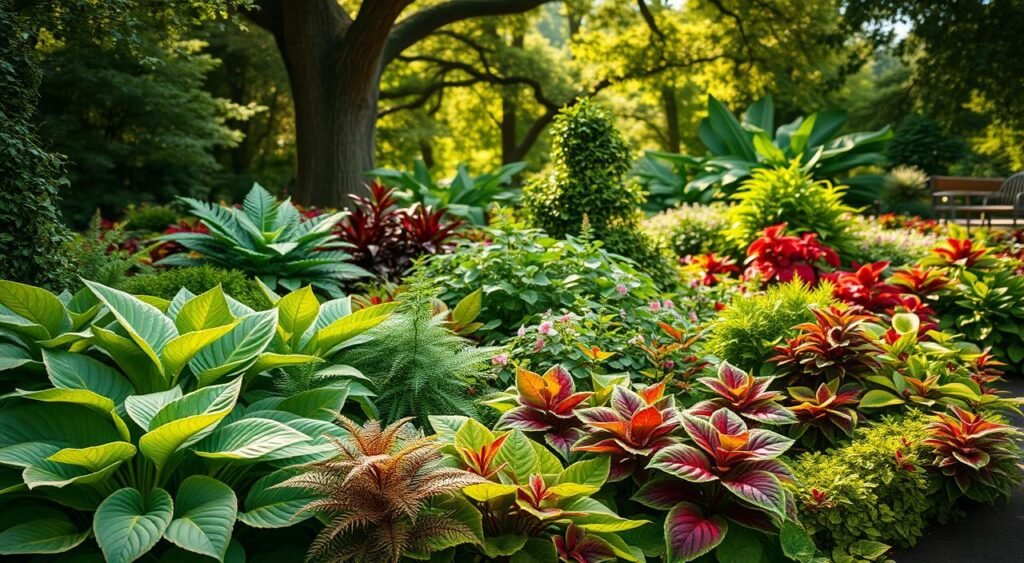Ever wonder why your shady garden spots stay barren while sunnier areas bloom? What if I told you those shadowy corners could be your most stunning features? Let’s debunk the myth that shade means a dull garden. I’ve spent years transforming overlooked areas into lush landscapes, and today I’m sharing my secrets.
Shade plants for gardens aren’t just filler—they’re stars in their own right. The best shade plants, like Hostas and Hellebores, turn dappled sunlight into opportunities for bold foliage and blooms. Imagine purple-leafed Heuchera lighting up a corner, or ferns adding texture under trees. Even if you think shade is a challenge, I’ll prove it’s a chance to grow plants like Astilbe or Coral Bells with ease.
These shade loving plants aren’t just for experts. Whether you’re in USDA Zone 3 or 9, there’s a plant here for you. Let’s uncover how perennials like Ligularia or Jacob’s Ladder can thrive where others fade. Ready to turn those dark patches into your garden’s highlight?
Key Takeaways
- Shade plants for gardens include hardy perennials like Hostas and Ferns that return yearly.
- Best shade plants like Hellebores and Bleeding Hearts thrive in partial to full shade with minimal upkeep.
- Deer-resistant options like Brunnera Jack Frost and Lungwort protect your investment without harsh chemicals.
- USDA zones 3-9 offer a wide range of choices from blooms like ‘Chantilly Lace’ Goatsbeard to variegated foliage.
- Even small spaces can shine with compact varieties like Vinca Minor or Coral Bells.
Understanding Shade in Your Garden: Types and Challenges
Ever wondered why some plants thrive in shade while others struggle? Let’s break down light conditions to unlock your garden’s full beauty. Knowing your shade type is key to selecting the right shade tolerant plants for your space.
Identifying Different Types of Shade
| Shade Type | Description | Plant Examples |
|---|---|---|
| Dappled Shade | Light filtering through tree canopies – think sun flecks on forest floors. | Ferns, hostas, and astilbe |
| Partial Shade | 3-6 hours of direct sun, often morning or afternoon only. | Coral bells, heuchera, or tiarella |
| Full Shade | Less than 3 hours of direct sun daily. | Wild geraniums, foamflower, or black cohosh |
| Deep Shade | No direct sun – north-facing walls or dense tree clusters. | Mosses, wood anemones, or certain fern varieties |
For instance, hostas adore dappled shade, while foamflower excels in full shade. Use this guide to find the perfect plants for shaded areas for your garden.
Measuring Light Levels in Your Garden
- Track sun patterns with a calendar and clock – note where sunlight hits at 10 AM, noon, and 2 PM.
- Use a light meter app (like “Light Meter Pro”) for exact readings.
- Observe seasonal shifts – a spot might be partial shade in summer but full shade in winter.
Common Challenges of Shade Gardening
Dealing with tree roots? I’ve found mulching helps retain moisture and suppress weeds. Soil fertility? Amend a slow-release fertilizer in spring. Remember, landscaping with shade plants is about working with nature, not against it! Ask me about my favorite organic soil mixes for shaded beds.
- Root competition: mulch 2-3 inches thick to deter weeds and retain moisture.
- Soil issues: Amend a 2-3” mulch layer to improve soil health over time.
- Moisture extremes: Use raised beds in soggy spots or add compost to dry soils.
Ready to transform your shaded spaces into stunning displays? Begin by mapping your garden’s light – your plants for shaded areas will appreciate it!
The Benefits of Creating a Shade Garden
Ever thought shade was a gardening curse? Think again! Shade gardens open doors to unique plants and practical perks you won’t find in sun-drenched spots. Let me break down why shade garden plants could be your new favorite design strategy.
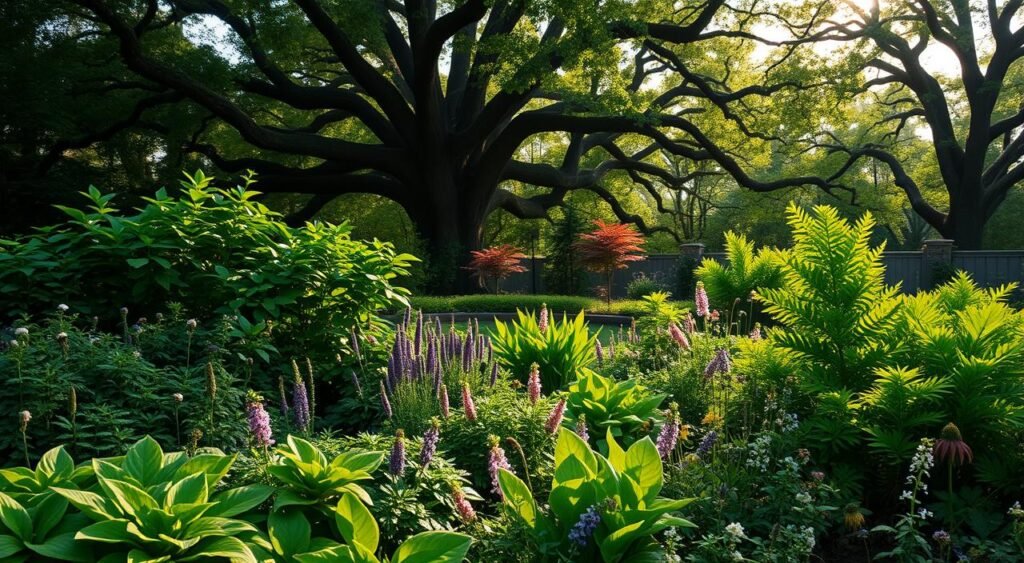
- Less work, more results: Shade cuts evaporation, so shade plants for gardens stay hydrated longer. You’ll water less and save on your water bill!
- Pest-free oasis: Insects like aphids prefer sun—your plants get a natural shield.
- Year-round drama: Plants like variegated hydrangea and ajuga thrive in low light, providing bold foliage all season.
| Benefit | How It Works | Top Picks |
|---|---|---|
| Energy savings | Shade trees reduce AC use by cooling outdoor spaces | Maple, oak, or birch trees |
| Low maintenance | Less sun = fewer weeds and wilting | Ferns, hostas, caladiums |
| Visual interest | Textural leaves and blooms that shine without blooms | Mondo grass, lilies, and caladiums |
And let’s not forget the plants for shaded areas that add luxury without hassle! Try Coolaroo shade cloth to protect delicate blooms from harsh midday sun. With these strategies, you’re not just growing plants—you’re crafting a sanctuary that’s as easy on the eyes as it is easy to maintain. Ready to turn that shady corner into a showstopper? Let’s dive into the best picks next!
Best Shade Plants for Gardens: A Comprehensive Guide
Ready to transform your shady spaces into a vibrant oasis? Let’s dive into the best shade plants tailored for every corner of your garden. Whether you crave blooms, bold foliage, or low-maintenance options, these picks deliver style and substance.
Flowering Shade Plants
Turn shadows into floral masterpieces with these stunners:
- Hellebores – Bloom in winter, showing off cup-shaped flowers in pink, green, or white.
- Epimedium – Adds dainty yellow or pink blooms alongside heart-shaped leaves.
- Astilbe – Fuzzy plumes of pink, red, or white flowers on top of ferny-like foliage.
Foliage-Focused Shade Plants
Bring drama without flowers using these leafy gems:
- Hosta – Thousands of varieties in blue, gold, or variegated shades. Try ‘Sum and Substance’ for giant, butteryellows.
- Japanese Painted Fern – Silvery-green fronds with crimson edges.
- Brunnera ‘Jack Frost’ – Silver leaves with dark veins – a year-round showstopper.
Native Shade Plants for American Gardens
| Plant | Height | USDA Zone | Why Choose? |
|---|---|---|---|
| Virginia Bluebells | 12-24” | Zones 3-8 | Soft blue flowers in spring; pairs well with ferns. |
| Solomon’s Seal | 2-3’ | Zones 3-7 | Arching stems with dangling white blooms; deer-resistant. |
| Woodland Phlox | 6-12” | Zones 4-8 | Compact mounds of pink or purple blooms in spring. |
Exotic Shade Plants That Adapt Well
Global flair meets practicalityy:
- Hakonechloa – Golden grass that cascades gracefully in part shade.
- Chocolate Vine – Trailing purple-black foliage with sweet-scented pink flowers.
- Coral Bells – Bold leaves in wine-red, chartreuse, or copper tones.
Pair these shade loving plants with the right conditions, and watch your garden thrive season after season.
Perennial Shade Plants That Return Year After Year
Perennial shade plants are a true marvel of nature, returning stronger with minimal effort each season. They transform shady areas into vibrant, year-round displays. I’ve explored numerous varieties, focusing on those that combine stunning beauty with unmatched durability. Let’s dive into three standout categories that excel throughout the seasons.
“Perennial shade plants are the easiest plants you can grow – ignore them! They’ll love you!”
Spring brings color with the arrival of perennial bloomers. Hellebores (zones 3-8) bloom in late winter, flaunting cup-shaped flowers in deep shade. Woodland phlox adds a touch of delicate pink, while Virginia bluebells (zones 3-8) paint the garden with soft blue hues. These plants thrive in well-drained soil, requiring only a spring mulch.
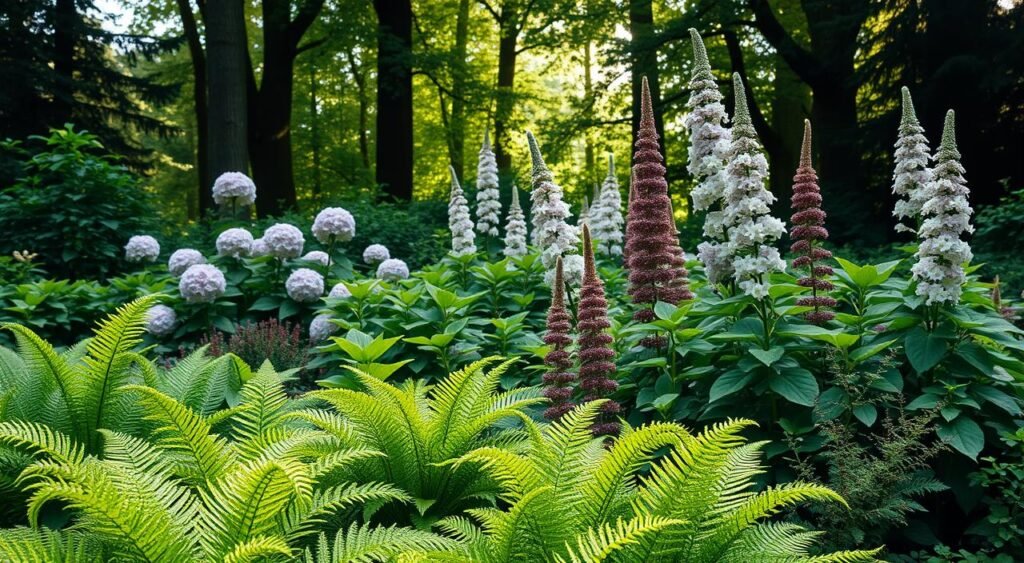
Summer and fall bring their own set of stars. Toad lilies (zones 3-8) unfurl orchid-like blooms in August. Liriope (zones 4-9) offers grassy foliage and purple berries, while foamflower (zones 3-9) blooms with frothy white flowers midsummer. These plants are heat-tolerant once established, requiring only deep watering during dry spells.
Evergreens like Christmas fern (zones 3-9) maintain lush foliage year-round. Ajuga (zones 3-9) forms evergreen carpets, while Japanese painted fern (zones 5-8) adds feathery fronds that shine in low light. Pair them with hosta (zones 3-9) for bold, part-shade foliage.
My clients rave about bigroot geranium (zones 4-8), which blooms all summer in part shade. Yellow corydalis (zones 3-9) spills over edges in containers or beds. Most perennial shade plants naturally multiply, requiring division every 3-5 years for free plants to expand your garden or share with neighbors.
Shade-Loving Shrubs for Structure and Privacy
Looking to add height and privacy without sunlight? Let me introduce shrubs that thrive in shade and transform your garden. These shade loving plants offer year-round structure and screening power. Perfect for corners or borders, they turn low-light areas into lush focal points.
| Shrub | Size | Use |
|---|---|---|
| Hydrangea quercifolia | 6-15 ft tall | Winter texture + summer blooms |
| Interstella® pieris | 3-12 ft tall | Border screening with pink flower clusters |
| Kodiak® diervilla | 2-4 ft | Compact hedge for small spaces |
| Vanilla Spice® summersweet | 2-8 ft | Summer fragrance + autumn color |
Evergreens like yew and boxwood create dense screens even in deep shade. Deciduous shrubs like beautyberry add seasonal interest with purple berries. Mix them to balance structure and color! For example, try pairing rhododendrons with compact hollies for a layered look.
“Privacy doesn’t mean sacrificing beauty – these plants for shaded areas deliver both.”
Need a quick fix? Fast-growing best shade plants like serviceberry offer spring flowers and fall color. Slow-growers like mountain laurel become long-term investments. Always match shrub size to your space – camellias work well as foundation plants, while tall yews form 15+ foot screens. With the right choices, you’ll enjoy both visual appeal and functional privacy. Let these shrubs work double-duty in your garden’s design!
Ground Covers and Low-Growing Plants for Shaded Areas
Ground covers are a game-changer for filling shady spots. They transform dark corners into vibrant, living carpets, requiring little upkeep. Here are my top picks for shade garden plants that blend beauty with practicality.
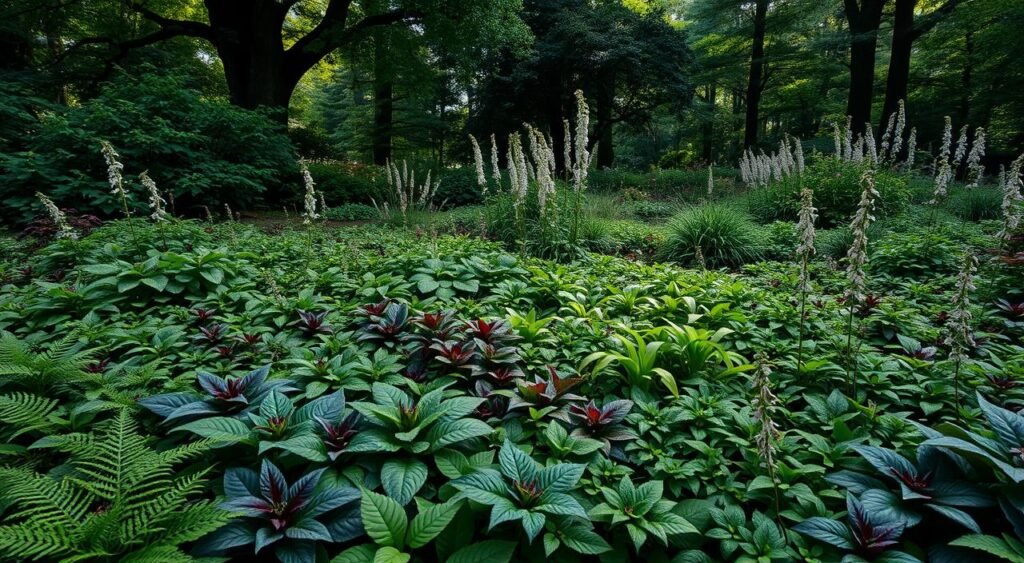
Fast-Spreading Ground Covers
For immediate results, opt for plants that spread quickly but don’t overwhelm. My go-to choices include:
- Vinca Minor – Evergreen with violet-blue blooms (adds a splash of color without dominating the space).
- Waldsteinia ternata – Yellow spring flowers on creeping mats, excels in dry shade.
- Sweet Woodruff (Galium odoratum) – Fragrant white flowers in spring, ideal under trees.
Slow-Growing, Low-Maintenance Options
These shade loving plants reward patience with their growth:
- Allegheny Spurge – Evergreen with silver-edged leaves, spreads gently via rhizomes.
- Liriope – Foliage in shades of green or purple, blooms in spikes of lavender or white.
- Epimedium – Heart-shaped leaves and delicate flowers, thrives in dry shade.
Flowering Ground Covers for Shade
Introduce color to dark areas with these flowering ground covers:
- Creeing Phlox – Carpet of pink or white blooms in spring (essential for shade garden plants).
- Foamflower (Tiarella) – White or pink plumes above textured foliage.
- Big Root Geranium (Geranium macrorrhizum) – Purple-pink flowers and aromatic leaves.
Whether you seek speed or style, these shade garden plants transform problem areas into lush, low-maintenance wonders. Mix textures and colors to add depth. Your garden will flourish with minimal effort!
Ferns, Hostas, and Other Classic Shade Tolerant Plants
In the realm of shade garden plants, ferns and hostas stand out as the top performers in low-light environments. These best shade plants flourish in areas where most struggle, showing that even the darkest spots can come alive. We’ll explore how to select the perfect varieties and combine them effectively.
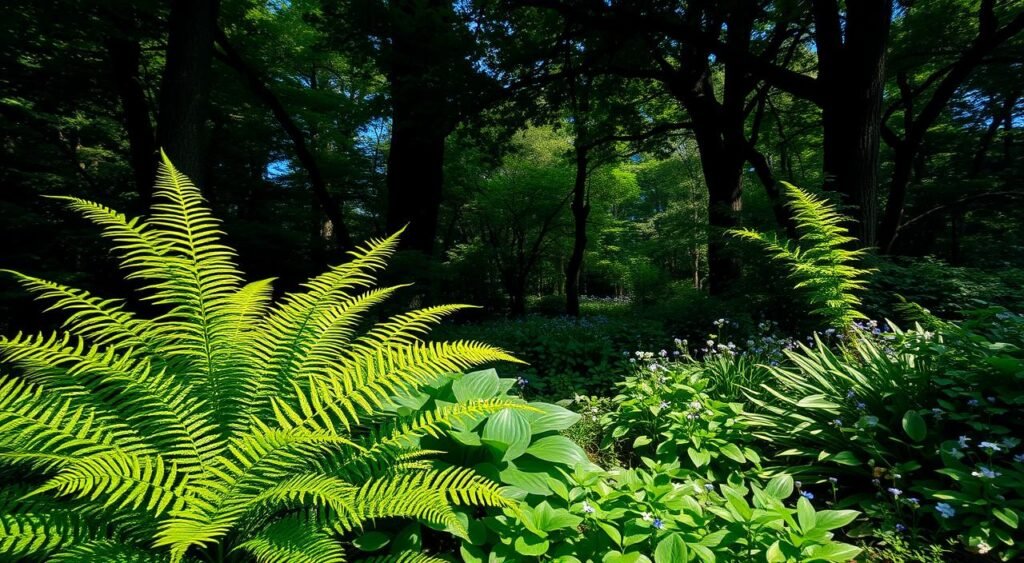
Fern Varieties for Different Garden Conditions
Choose the right ferns for your garden:
| Plant | Zones | Height | Ideal For |
|---|---|---|---|
| Japanese Painted Fern (Athyrium niponicum) | 3-8 | 20-22″ | Moist soil + silver-blue fronds |
| Autumn Fern (Dryopteris erythrosora) | 5-9 | 2′ | Coppery spring growth |
| Christmas Fern | 3-9 | 1.5-3′ | Year-round evergreen texture |
Hosta Varieties: From Miniature to Giant
Hostas come in a wide range of sizes and colors. Consider:
- ‘Blue Mouse Ears’ – 6″ tall blue-green mounds for containers
- ‘Empress Wu’ – 6′ wide giants with bold yellow margins
- Variegated varieties like ‘Patriot’ – they light up dark spots like nature’s nightlights!
Companion Plants for Ferns and Hostas
Pair these stars with:
- Heuchera (coppery leaves) for contrast
- Hakonechloa grass – golden arching mounds add motion
- Pulmonaria blooms in spring before foliage unfurls
These combinations can transform ordinary shade into a vibrant tapestry. Begin with small steps, experiment, and watch your garden evolve—no magic needed!
Creating a Stunning Shade Garden Design
Designing a shade garden is not about less—it’s about more creativity! Start with structure using shade-tolerant shrubs like Japanese maples (Acer palmatum) or dogwoods. These trees cast dappled light, creating drama without overwhelming space. Next, layer in mid-height shade garden plants like hostas and ferns. Pair bold hosta leaves with delicate Japanese forest grass (Hakonechloa) for texture contrast that pops!
Ground covers are your secret weapon. Use epimedium or pachysandra to blanket bare soil, tying the space together. For focal points, cluster spring ephemerals like hellebores near paths—their blooms surprise visitors early in the season. And don’t forget movement! Wind-swaying Aruncus adds life where sunlight fades.
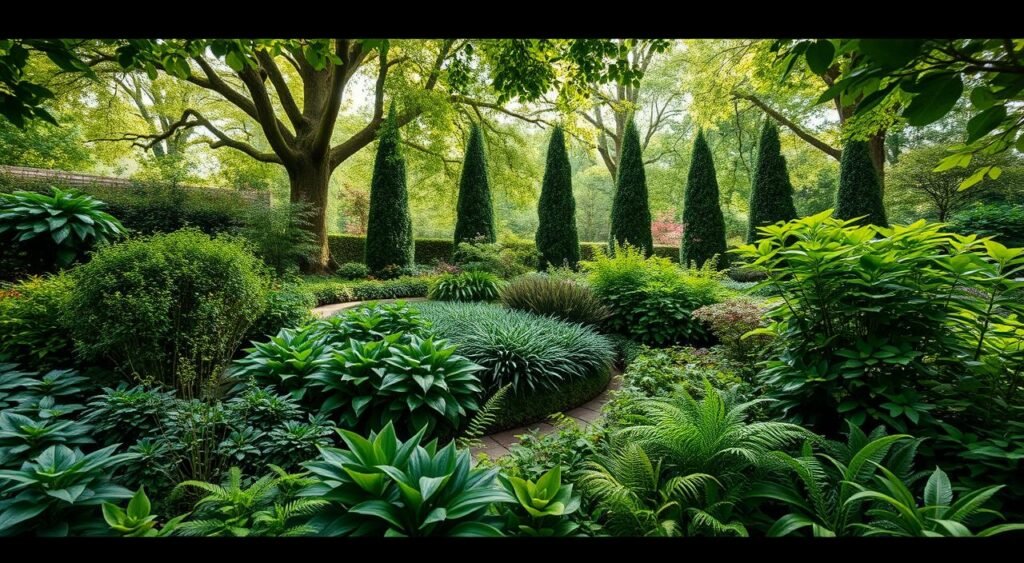
Think beyond plants too! Place a stone bench under a maple canopy or scatter river rocks with variegated Solomon’s seal. Remember, shade plants for gardens thrive when grouped thoughtfully. Mix evergreens like leatherleaf ferns with seasonal bloomers like astilbes for year-round interest.
“A well-designed shade garden isn’t just about survival—it’s about storytelling through texture and light.”
Pro tip: Use pots of coleus or caladiums as movable accents in partial shade spots. Swap them out seasonally to keep your design fresh. With these strategies, your shady areas become focal points everyone admires!
Soil Preparation and Planting Techniques for Shade Plants
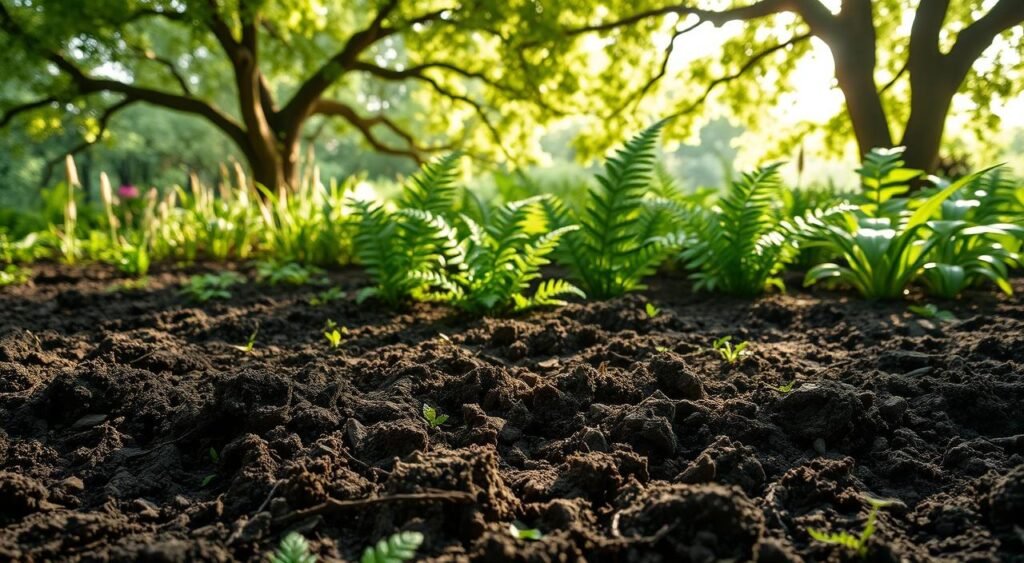
Getting your soil right is the secret to thriving shade garden plants. I’ll share my top strategies to ensure your plants thrive—no need for a science degree!
Understanding Soil Requirements
Shade-loving plants prefer loose, airy soil with plenty of organic matter. Imagine their natural habitat—decaying leaves and dappled sunlight. Begin by testing your soil pH; most shade plants for gardens thrive in slightly acidic to neutral conditions (5.5–7.0).
If your soil is clay-heavy, mix in peat moss or coir for better drainage. For sandy soil, add compost to improve moisture retention and feed soil microbes.
Amending Soil for Optimal Growth
Here’s my go-to formula:
- Layer 3–4 inches of compost or leaf mold over the planting area
- Work in 1 part organic matter to 2 parts native soil
- Add coarse sand to heavy clay soils (no more than 25% by volume)
Avoid compacting the soil—gentle digging is best. Plants likeshade loving plants such as Hosta and Ferns need room to breathe!
Proper Planting Depths and Spacing
Plant roots should sit at ground level—not buried! Dig holes twice as wide as the root ball but only as deep as the container. Space plants using this rule:
“If it grows 18 inches wide, give it 18 inches of space.”
Mulch with 2–3 inches of shredded cedar to lock in moisture. And remember: overcrowding leads to disease—keep those plants chatting, not elbowing!
Watering and Fertilizing Tips for Low Light Plants
Ever wonder how to keep shade plants thriving without overdoing it? Let’s get practical! Shade plants for gardens like ferns and hostas need careful care. Here’s how to balance watering and feeding without stressing your plants—or yourself.
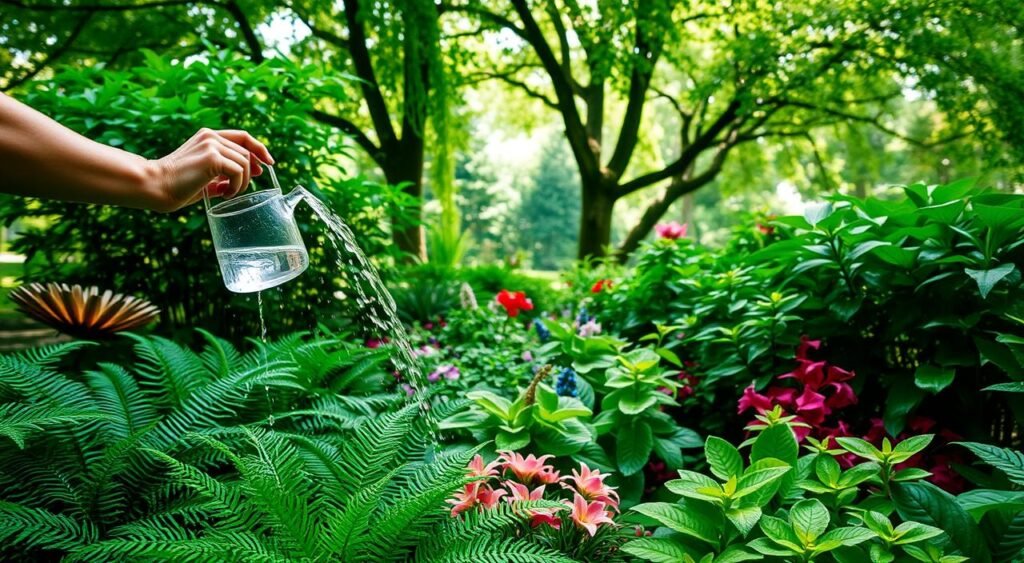
First rule? Don’t overwater! Shade tolerant plants often grow under trees where roots steal moisture. Use this trick: stick your finger into the soil. If it’s dry 1–2 inches down, water deeply. Newly planted specimens? Water twice weekly until roots settle in.
- Water deeply but sparsely—allow soil to partially dry between sessions
- Avoid overhead watering to prevent leaf rot
- Mulch with 2–3″ of shredded bark or compost to lock in moisture
Fertilizing? Less is a must! Most shade plants evolved in nutrient-poor soils. Use slow-release organic fertilizers like Milorganite at half the recommended dose. Skip high-nitrogen blends—they trigger weak growth prone to pests. Time applications for early spring and mid-summer for best results.
Pro tip: Enrich soil yearly with compost. This builds long-term health without shocking delicate roots. And never let mulch touch plant stems—it’s a rot magnet.
Got a dry spot under oaks? Water directly at the base using a soaker hose. Pair with a balanced liquid fertilizer diluted to half strength every 6–8 weeks during growth spikes. Trust your instincts—your shade garden’s success starts with these simple steps!
Seasonal Care and Maintenance of Shade Garden Plants
To keep your shade garden vibrant all year, understand what each season requires. These simple steps help your perennial shade plants stay healthy with minimal effort. Let’s explore the care calendar for shade plants that flourish through every season!
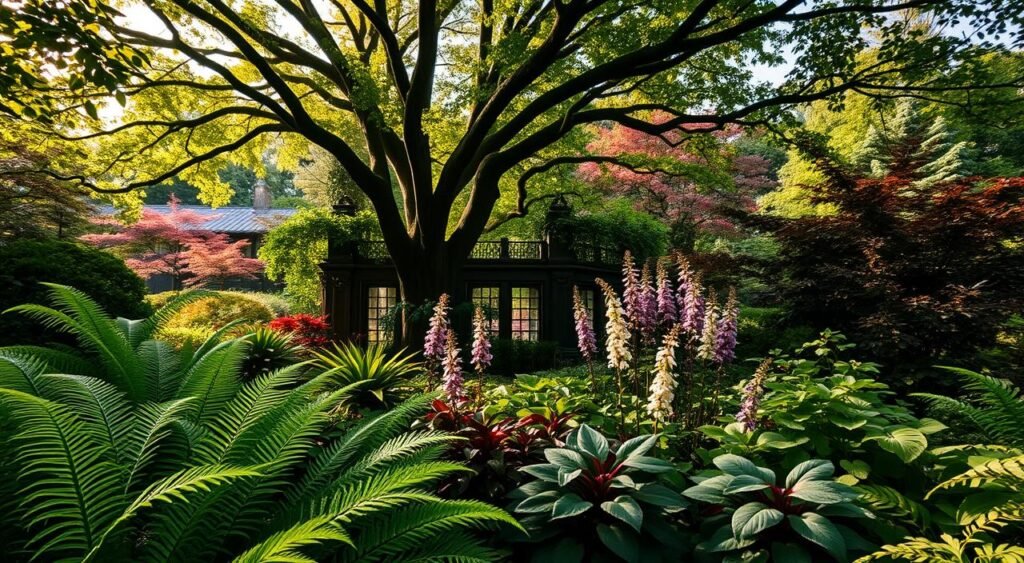
| Plant Name | USDA Zones | Optimal Light | Seasonal Care Tips |
|---|---|---|---|
| Funshine® abelia | 4-11 | Partial sun to part shade | Prune after spring bloom. Mulch roots in winter. |
| ‘Dark Side of the Moon’ astilbe | 4-8 | Partial shade | Deadhead spent blooms in summer. Protect from frost in fall. |
| Surefire® ‘Blue Ripples’ primrose | 2-8 | Partial shade | Divide every 3 years in spring. Avoid wet soil in winter. |
Here’s how to tackle each season:
Spring Care Routine
- Clean up garden beds gently—wait until 50°F+ to remove winter debris.
- Divide overgrown perennials like hostas and ferns to boost growth.
- Apply compost as mulch but keep it away from plant crowns.
Summer Maintenance
Water deeply with soaker hoses at soil level to prevent fungal issues. Watch for slugs—use iron phosphate baits. Deadhead blooms on astilbes and begonias to encourage reblooming.
Fall Preparation
Leave seed heads and stems for winter interest. Mulch with shredded leaves, but keep 2” away from stems. Trim dead foliage from evergreens like holly ferns.
Winter Protection
Shield borderline hardy plants with burlap screens. Apply anti-desiccant sprays to broadleaf evergreens. Check mulch layers to protect roots from freezing.
Remember: Most perennial shade plants are tougher than they look! By following this care calendar, your shade plants for gardens will reward you with lush growth and minimal hassle. Stay observant—small adjustments now mean big differences later!
Troubleshooting Common Problems with Plants for Shaded Areas
Even the most meticulously planned shade gardens encounter obstacles. Let’s address these issues swiftly to ensure your shade loving plants flourish. Here’s how to handle common problems:
- Deer Munching Hostas? Safeguard your prized plants, such as Pulmonaria ‘Trevi Fountain’, with Deer Stopper spray. Copper barriers are also effective for protecting delicate shade tolerant plants like Bergen ‘Angel Kiss’.
- Fungal Spots? Powdery Mildew? Remove infected leaves promptly. Use neem oil sprays for treatment and enhance airflow by pruning tree branches. Always avoid wetting the foliage when watering.
- Root Competition? Stunted Growth? Create planting pockets with compost-rich soil. Water deeply at ground level using basins to circumvent thirsty tree roots.
- Slugs Eating Leaves? Opt for natural solutions over chemicals. Beer traps, iron phosphate pellets, or gritty mulch can help. Inspect under leaves at dawn, as slugs are most active then.
- No Blooms? Pale Leaves? Insufficient light might be the issue. Prune overhanging branches to allow dappled light. Consider variegated Coral Bells (Heuchera) varieties, which thrive in dry shade.
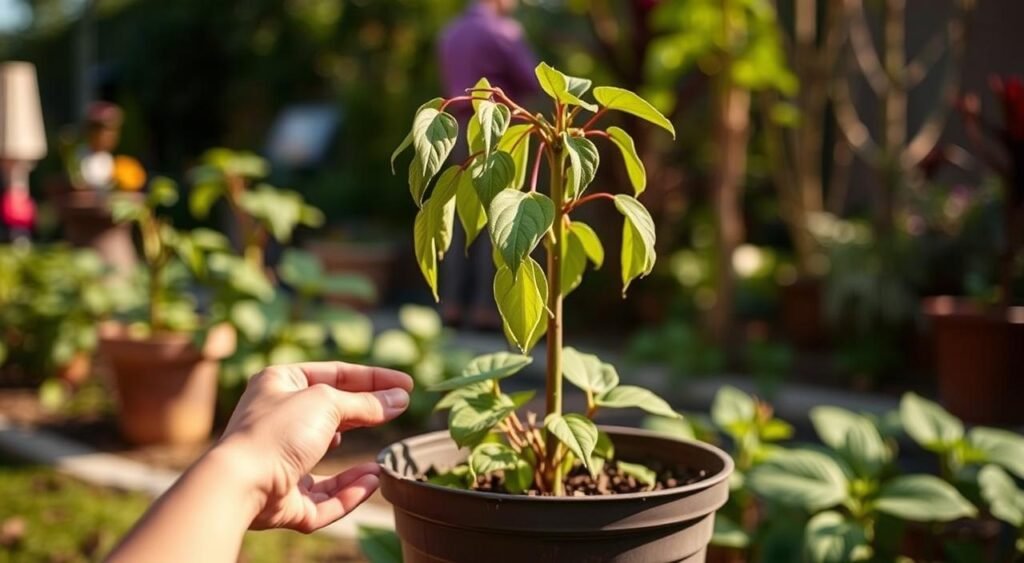
Be proactive! Regularly inspect your plants and take action promptly. Healthy soil is key to healthy plants. Add compost annually and avoid overcrowding. Your shade garden deserves effective solutions, not complex tricks. Simple, smart gardening is the way forward.
Landscaping with Shade Plants: Beyond the Basics
Ready to elevate your shade garden into a masterpiece? Let’s explore beyond the basics and dive into creative design strategies. Start by selecting bold focal points, such as a Japanese maple’s unique branches or a group of variegated hostas. These elements naturally draw the eye and add drama, even in low light.
“A well-placed Japanese maple becomes a living sculpture, transforming ordinary shade into a focal point.”
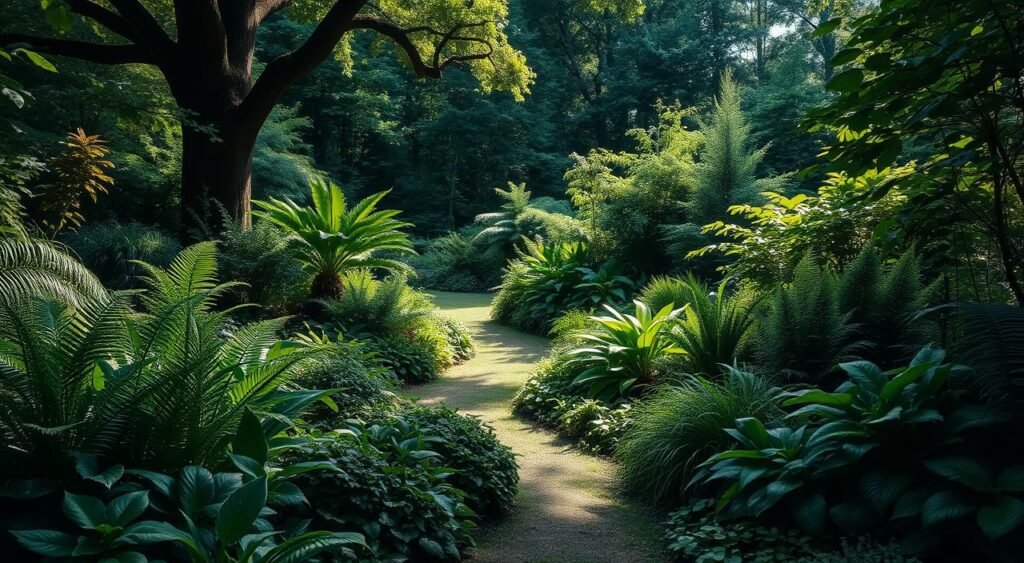
To add depth, mix textures and heights. Pair the delicate fronds of ferns with the bold leaves of ligularia for striking contrast. Layer plants like creeping thymes under taller foxgloves or hydrangeas. Group 3-5 plants with different leaf shapes in tight clusters to create “texture vignettes” that stand out in shady areas.
Introduce hardscape elements that harmonize with nature. Lay stepping stones in mossy pathways or add a rustic bench near a water feature. Even small touches, like a stone trough with sweet potato vines, can add luxury without overwhelming the space. Choose natural materials like untreated wood or river rocks to maintain cohesion.
- Use focal points: Unique trees or plants as centerpieces
- Layer textures: Mix fine, bold, and midsize leaves
- Blend hardscapes: Moss, stone, or wood for subtle accents
Remember, shade plants are not just for survival; they’re a canvas for art. Experiment with lighting, using solar path lights or under-canopy bulbs to highlight foliage at night. Don’t overlook vertical spaces! Train climbers like ivy on trellises to make the most of every inch. With these strategies, your shade garden becomes a sanctuary that feels intentional and vibrant.
Container Gardening with Shade Tolerant Plants
Container gardening offers a fresh way to grow shade tolerant plants, even in tight spaces. I’ll share my favorite picks and tips for creating stunning displays in low light areas. For a vibrant touch, choose low light plants that thrive in pots. Start with light-colored pots to reflect light and keep roots cool. Use large containers (14–18 inches wide) to hold moisture and support root growth.
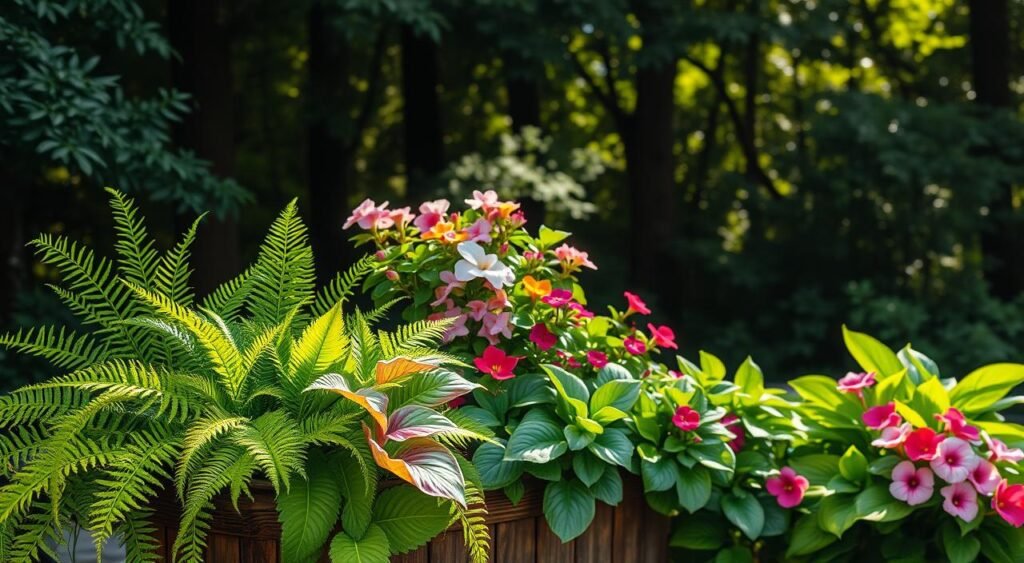
Let’s dive into the best shade plants for pots! Begin with a thriller, filler, and spiller combo. For the thriller, bold plants like Blood leaf (Iresine lindenii) or Caladium bicolor ‘Rosalie’ make a statement. Fill with flowering plants such as Begonia ‘Dragon Wings Hybrid’ or Impatiens ‘Pink Ice’. Add trailing plants like Creeping Jenny or Catalina® Midnight Blue wishbone flower to spill over. Mix these in a 14-inch pot for a lively display.
| Plant | Key Features | Zones |
|---|---|---|
| Begonia ‘Dragon Wings’ | Shiny leaves + red blooms; thrives in partial shade | 8–11 |
| Shadow Dancers® Hosta | Variegated leaves; spreads to 14–30″ wide | 3–9 |
| Catalina® Midnight Blue wishbone flower | Trailing habit; blue-green blooms | 10–11 (annual elsewhere) |
Seasonal swaps keep containers looking fresh. In spring, try primroses and violas. Summer brings out coleus and impatiens. For fall, cyclamen or ornamental kale are perfect. Always use pots with drainage holes and a mix of potting soil, compost, and moisture crystals. Water when the top inch of soil dries out—avoid overwatering. Enhance your display with hardscaping elements like trellises or stepping stones. For instant drama, group 3–5 pots of varying heights and textures.
Ready to brighten your shady spot? Container gardening lets you experiment with bold colors and textures. Start with a begonia combo and scale up as you gain confidence. What will your first container design feature?
Conclusion: Embracing the Beauty of Shade in Your Garden
Shade doesn’t have to be a neglected part of your yard. With the right shade plants, shadowy spots can become your favorite retreat. Hostas and ferns create a lush backdrop, while bleeding hearts add vibrant colors. These plants transform underused spaces into vibrant ecosystems.
Astilbes with their feathery blooms or autumn ferns for drier areas thrive where others struggle. Mixing textures, like bold hosta leaves with delicate Japanese painted ferns, adds depth. This creates a visually appealing space.
Every shaded area has its own unique charm. Begin by testing your soil and adding compost. Choose plants that match your conditions. Shade loving plants like impatiens or coral bells attract pollinators and boost biodiversity.
Add paths of gravel or mulch, or a small fountain, to enhance your space. Even small balconies can bloom with the right plants. This turns them into a vibrant oasis.
Shade gardening is a journey of discovery. Observe how plants adapt and swap out varieties each season. Heucheras’ ruffled foliage or wild ginger’s low-spreading leaves can guide your design. These plants are not just survivors; they are the stars that turn shadows into beauty.
Grab your tools and transform those dark corners into a sanctuary. Let nature’s quiet elegance shine in your garden.
FAQ
What are the best shade plants for my garden?
For a vibrant garden, consider flowering shade plants like bleeding hearts and hellebores. Also, think about foliage-focused options such as hostas and ferns. Native shade plants, like Virginia bluebells, and exotic varieties, like Japanese forest grass, are also excellent choices. Each type thrives in different shade conditions, ensuring your garden is full of life.
How do I identify different types of shade in my garden?
Shade types include dappled, with flickering light; partial, with 3-4 hours of sun; full, with less than 3 hours of sun; and deep, with no direct sunlight. Knowing these categories helps you pick the right plants for each area.
What common challenges should I expect when gardening in shade?
Challenges include competition with tree roots, excess moisture, and fungal issues. There’s also a limited plant selection. But, I have practical solutions to help your shade plants thrive, overcoming these obstacles.
Why should I create a shade garden?
Shade gardens need less maintenance and offer natural cooling zones. They provide unique textures and are less prone to pests and drought. This makes them a great choice for gardeners.
What soil conditions do shade plants prefer?
Shade plants prefer slightly acidic to neutral soil (pH 5.5-7.0). Improving soil quality with compost or well-rotted leaf mold enhances moisture retention and nutrient availability, helping plants flourish.
How do I maintain my shade garden throughout the seasons?
Maintenance includes seasonal routines. Clean up old leaves in spring, water properly in summer, and mulch for winter. Regularly observe your plants to address any issues.
Can I use ground covers in my shade garden?
Yes! Ground covers like sweet woodruff and periwinkle suppress weeds and prevent erosion. They fill in bare patches, creating a lush look in shaded areas.
What are some good companion plants for ferns and hostas?
Heuchera (coral bells) contrasts well with bold hosta leaves. Spring bulbs like snowdrops add early interest. Japanese forest grass adds texture, making a great combination.
How can I design a captivating shade garden?
Begin with a strong structural framework of shade-tolerant shrubs. Layer in diverse textures and heights. Include focal points, like striking Japanese maples or unusual ferns, for visual interest.
What are the advantages of container gardening with shade tolerant plants?
Container gardening offers flexibility, displaying shade-loving plants in challenging spots. Use larger pots for moisture consistency. Combine thriller, filler, and spiller plants for stunning arrangements that brighten shady corners.
